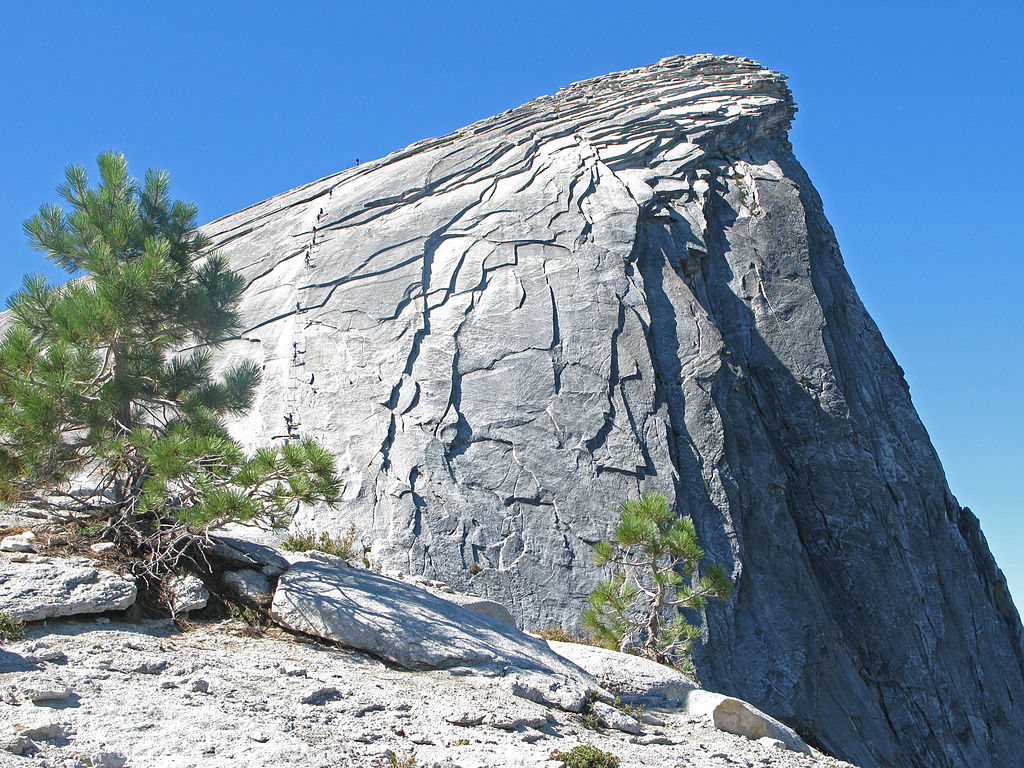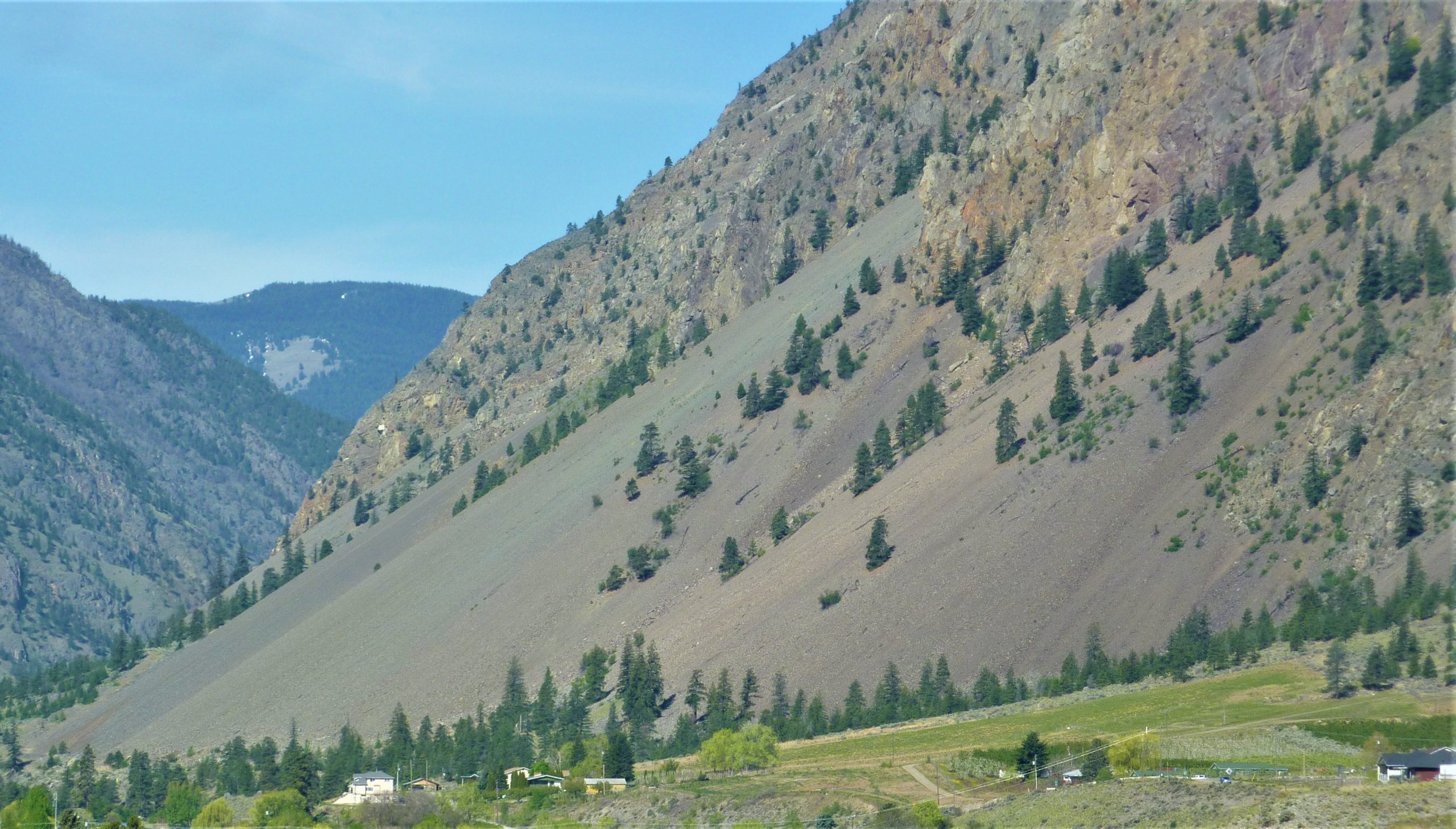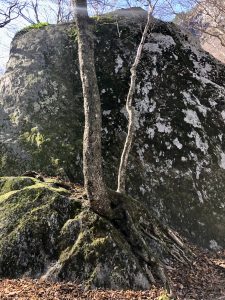6.1 Mechanical Weathering
While most rocks form at great depths within the Earth’s crust, sediment forms on the surface due to weathering. Weathering occurs when rocks are subjected to the action of water, extremes of temperature, or due to biological activity. Mechanical weathering, sometimes referred to as physical weathering, refers to the process that breaks rocks apart without changing their chemical composition. It is essentially a process that takes a big cohesive piece and turns it into a smaller fragment of the original material.
The most important agents of mechanical weathering are:
- The decrease in pressure that results from removal of overlying rock causing cracking in rocks
- Freezing and thawing of water in existing cracks in the rock
- Cracking from plant roots and removal of material by burrowing animals
Pressure Release
When a mass of rock becomes exposed at the Earth’s surface, it may have had kilometers of overlying rock already removed. The removal of the weight of that rock causes a decrease in the confining pressure on the rock, and the rock expands. This unloading promotes cracking of the rock, known as exfoliation, as shown in the granitic rock in Figure 6.1.1., which, in places, is peeling off like the layers of an onion.

Granite tends to have a homogenous texture, which means it typically displays uniform structure and composition. Because of this, granite doesn’t have predetermined planes along which it must fracture, and cracks therefore form parallel to the exposed surface, This gives outcrops like Half Dome (Figure 6.1.1), in Yosemite National Park, its unique appearance. Sedimentary and metamorphic rocks, on the other hand, tend to exfoliate along predetermined planes when responding to the pressure release process.
Frost Wedging

Water is an incredibly important agent in many weathering processes. When liquid water is cooled to the point of freezing, it expands by approximately 9%! This means that every water molecule that seeps into a crack, will expand as it is freezing and make the crack larger. This allows more water to fill the crack later, causing the process, called frost wedging, to continue (Figure 6.1.2).
The effectiveness of frost wedging is related to the frequency of freezing and thawing. For this reason, frost wedging is not a dominant process in central and southern Arizona, but it can occur in the north! Although, it would be most effective in a climate with higher humidity and fluctuating temperatures, like Canada, and can happen there on daily temperature cycles.
The result of frost wedging is most apparent in mountainous areas, with the formation of a talus slope—a fan-shaped deposit of fragments removed by frost wedging from the steep rocky slopes above (Figure 6.1.3).

Biologic Processes

Plants are important agents of mechanical weathering as well. Roots can find their way into the tiniest cracks, often because water collects there, and force the crack to widen as the roots grow. From the smallest flower to the largest tree, plant roots can cause significant weathering to rocks. Figure 6.1.4 shows a tree growing in the crack of a rock, pushing against the rock and enlarging the crack every year as it grows. Additionally, the rock is covered in moss and lichen. While they don’t have roots, they have structures called rhizomes that attach them to rocks and work in the same way as roots. Additionally, they excrete various organic acids that dissolve minerals. This dissolution is actually a form of chemical weathering that will be discussed in the following chapter.
Water
There are other processes that can cause mechanical weathering, and most of them have to do with water. The force falling rain and running water (streams) can exfoliate an outcrop. Frozen moving water (glaciers), can scour a rock surface. Wind can also exfoliate rocks through the abrasion of windblown grit, however this process is not as significant as those dominated by water. Water is also a major agent in chemical weathering.
***See 6.9 for Text and Media Attributions
pressure applied equally on all surfaces of a body
a process by which large flat or curved sheets of rock fracture and are detached from an outcrop due to pressure release
A felsic, intrusive rock with coarse-grained texture. Granite composes mountain cores and can be found on and within the continental crust.
 What is Geology?
What is Geology?
“Geology” comes from the Greek roots “geo” (earth) and “logy” (field of study), so it literally translates into the Study of Earth. While initial geologic observations were limited to materials found at the surface and processes that could be directly observed, it has evolved over time to encapsulate the study of Earth as a system. In the present day, geology encompasses the physical structure of the Earth, its change over time, and the dynamic processes that act on it. Geology is a science, which means it is both a body of knowledge about the natural world, as well as a process. That process, called scientific inquiry, studies the Earth through systematic observation, experimentation, and reasoning based on evidence. The result is that geology is an umbrella science that encompasses all biological, chemical, and physical processes that act on the planet and make up our world, but also how they have changed through time.
Learning Objectives
Type your learning objectives here.
- First
- Second

